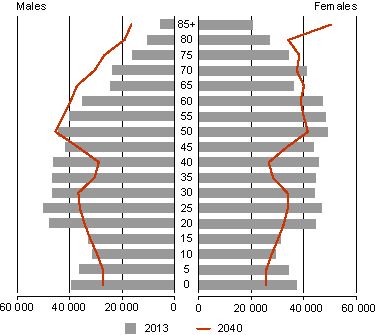Analytics, Demography, Education and Science, Estonia, Society
International Internet Magazine. Baltic States news & analytics
Tuesday, 23.04.2024, 12:20
The projected population of Estonia in 2040 will be 1,195,000
 Print version
Print version
As at 1 January 2013, the population of Estonia was 1,320,000. If the current demographic trends continue, Estonia’s population will decrease by 4,800 persons per year (0.4%), on average. External migration and natural increase have a more or less similar impact on the population decrease.
The age-sex distribution of the population will change by 2040. The differences in the share of women and men will get smaller – on the one hand, male life expectancy will increase; on the other hand, women will continue to make up a bigger share of emigrants. The main result is that the population will age considerably. The share of persons in retirement age (65 and older) in the population will rise from the current level (18.0%) to 27.6% by 2040. The share of children (aged under 15) will fall from 15.5% to 13.6%. Overall, the dependency ratio (the number of children and retired persons compared to the working-age population) will rise from 50.9% to 70.2% – in other words, there are currently two working-age persons per each dependant, whereas in 2040 there will be three working-age persons per two dependants.
The population projection was made in cooperation with the researchers of the University of Tartu. The projection is based on fertility, mortality and migration models, using the adjusted data for 2012 as input and assuming that the demographic trends of recent years will continue.
 |
| Population pyramid, 2013 and 2040 |
The projection was based on the following assumptions: life expectancy will continue to increase until the level of life expectancy currently applicable to persons with higher education, whereas the difference between male and female life expectancy will decrease; there will be a slight upward trend in the number of live-born children per woman; and net migration (i.e. the difference between immigration and emigration) will remain proportionally the same as in the recent years (both registered and unregistered migration is taken into account). These trends will cause changes in absolute figures, since the shares of age groups will change: the smaller generations born in the late 1990s and at the turn of the century are reaching their 20s.
As a result, emigration and fertility indicators will decrease in absolute terms. Also, the main processes that influence population trends in Estonia – birth rates and external migration – are strongly correlated: external migration decreases the number of women in childbearing age.








 «The Baltic Course» Is Sold and Stays in Business!
«The Baltic Course» Is Sold and Stays in Business!

